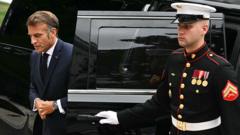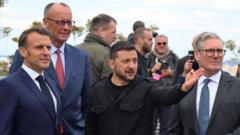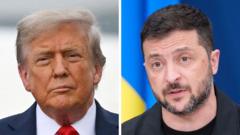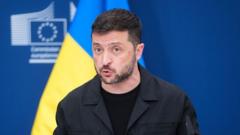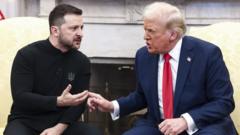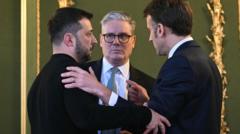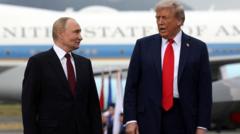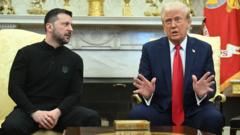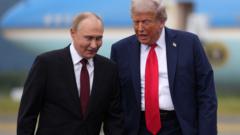President Zelensky's meetings in the White House reflect a complex interplay of diplomacy as he aims to secure support for Ukraine without escalating tensions further.
Zelensky's Visit to Washington: A Diplomatic Dance with Key Questions Unanswered

Zelensky's Visit to Washington: A Diplomatic Dance with Key Questions Unanswered
Ukrainian President seeks security assurances amid U.S. tensions and ongoing conflict.
In an effort to foster a more productive relationship, Ukrainian President Volodymyr Zelensky departed the White House unscathed after a crucial visit that did little to resolve the existing tensions between him and U.S. President Donald Trump. The atmosphere was markedly more cordial than during their contentious encounter earlier in the year, with both leaders presenting a front of cooperation even as their differences lingered. Zelensky donned a neat suit, prompting compliments from Trump, while he expressed gratitude repeatedly during their discussions.
Initially speaking little during his Oval Office visit, Zelensky seemed acutely aware that his priorities might diverge from Trump's latest stance. While they presented a united front during a joint press conference with European leaders—including German Chancellor Friedrich Merz and French President Emmanuel Macron—disagreements surfaced over the necessary steps toward a ceasefire in Ukraine. The European leaders advocated for immediate cessation of hostilities, while Trump maintained that a ceasefire should not precede a comprehensive resolution to the conflict. Zelensky remained quiet on this contentious topic.
Behind closed doors, discussions ostensibly veered towards security guarantees for Ukraine and the potential for Zelensky to sit down with Russian President Vladimir Putin—a meeting that has yet to materialize despite Zelensky's appeal for direct dialogue. He emphasized the need for robust security assurances, potentially encompassing a monumental $90 billion arms deal with the U.S., which would include various military assets crucial for Ukraine’s defense.
Notably, Zelensky also expressed enthusiasm for potential collaboration in drone technology, hinting that the U.S. would consider purchasing Ukrainian-built drones, which could bolster local manufacturing capabilities. Although formal agreements have yet to be inked, he suggested timelines for negotiations could crystallize within the next ten days.
Zelensky appeared eager to stress Ukraine's resilience in confronting Russian aggression, declaring that merely 1% of Ukrainian territory has fallen under Russian control in the last three years—a claim meant to clarify misconceptions at the White House about the state of the conflict. As the dialogue concluded, he described his overall experience as "warm," underpinning his desire to navigate the diplomatic landscape effectively.
In light of potential territorial concessions and the pressing question of how to unify the international approach to the conflict, Zelensky’s visit may have ultimately bought Ukraine some time. The outcome of the discussions may suggest a temporary stabilization of relations, but significant complexities remain unaddressed as the global community continues to monitor the evolving situation in Ukraine.


